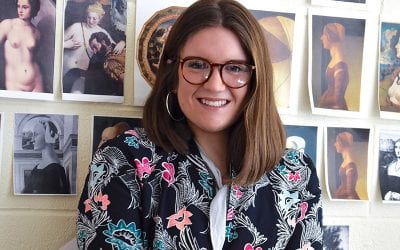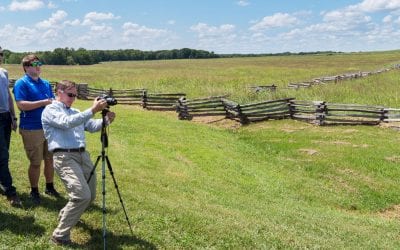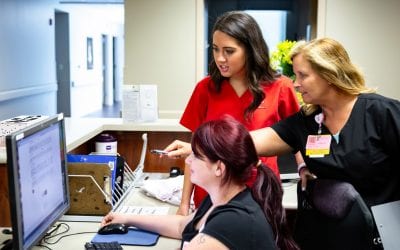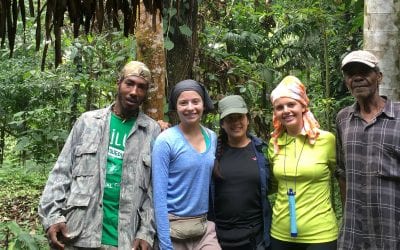
“These systems are very, very efficient – all the water in the loop is recycled. They also produce higher yields because you are able to tailor the conditions to what the plants like.”
By Samantha Kirby
Photos: Russell Cothren
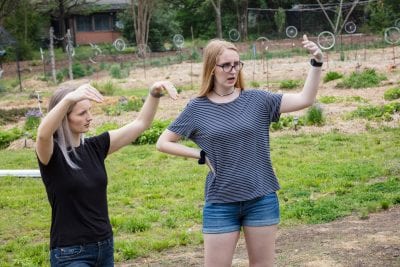
Sarah Gould (left) and Laura Gray visualize a
hydroponic green house for local non-profit Tri Cycle Farms.
Honors students Sarah Gould and Laura Gray stand between two wooden stakes embedded in the ground at local community garden Tri Cycle Farms, their arms spread wide. “The head house will go here, and the cold room here,” Gould says, almost to herself. The two take a few steps forward. “Here we’ll have the strawberry walls,” her arm sweeps across the space, “and in front of them will be 72 Dutch buckets for the tomatoes.” Until recently, the bare earth under their feet was covered in invasive wild roses scrabbling across a clogged natural drain. Today the empty space holds a vision: a greenhouse for hydroponically grown vegetables that will generate profits, and a sustainable future, for Tri Cycle Farms. Gould and Gray’s honors theses in biological engineering will help transform this vision into reality.
“Sometimes, all you need is a wheel and a push,” Gould recites. The saying contributed to the name of the farm, and also reflects owner Don Bennett’s philosophy: he established the garden first and foremost to serve. The farm gives away the majority of its produce to fight food insecurity in Northwest Arkansas, so this hydro house — which could bring in as much as $77,000 a year — would help alleviate the financial strain that such large-scale giving can often create. And Gould and Gray have been the push Tri Cycle needed to get it all started. “These women have just been amazing. I really appreciate how much they’ve learned about hydroponic systems,” Don says. “They have paved the way for other students to follow them and help make Tri Cycle more sustainable.”
Hydroponics is a method of growing plants without soil, which sidesteps many common environmental problems that can reduce vegetable yield, such as drought or soil-borne diseases. They preserve land by growing vertically rather than in horizontal rows, and perhaps most importantly, says Gray, “these systems are very, very efficient – all the water in the loop is recycled. They also produce higher yields because you are able to tailor the conditions to what the plants like.” Keeping plants in a greenhouse further enables growers to control environmental conditions and grow crops that might otherwise be unsuited to a particular climate.
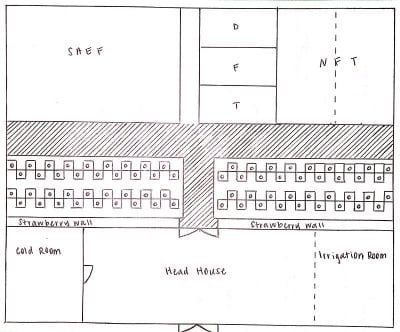
The plan for the hydro house includes a hydroponic wall for growing strawberries.
The debut lineup for the Tri Cycle hydro house will include tomatoes, strawberries, basil, lettuce and other leafy greens. As part of their project, Gould and Gray are developing their own hydroponic wall for growing the strawberries, which will be one of several different systems in use in the hydro house. Solar panels will power greenhouse activity.
Even in the farm’s pursuit of profit, Tri Cycle owner Don Bennett’s community focus is evident. “Don didn’t want to compete with other growers in the area, because that’s not productive for him,” Gould says. “So we’re doing reverse seasonality, by trying to grow what other growers don’t typically sell during a season.” This means Tri Cycle will be able to provide the community with strawberries and tomatoes in the fall and winter, and leafy greens in the summer, inverting these plants’ usual market presence.
To decide what to grow in the house, Gould contacted local groceries and restaurants to see what the community would be most interested in buying. While Gould has been preparing a business plan and drawing up blueprints for the hydro house systems for her thesis, Gray is focusing primarily on the project’s light and power requirements and will be creating an economic analysis of the greenhouse. And with a little guidance from horticultural engineer and U of A alum Joseph Chidiac (B.S.B.E., ’11; M.S., horticulture, ’17), they’ve taken complete charge of the work. The pair’s mentor, Marty Matlock, a professor of ecological engineering who serves as executive director of the Office for Sustainability, has helped them by keeping the reins very loose. “He’s very much a hands-off mentor,” says Gould. “He’s put a lot of trust in us, which really helps our confidence. We’re like project managers for a non-profit.”
Neither of these two “hippie engineers” intends to abandon her community focus after graduation. “Both of our hearts are in community service,” Gould says. For her, this will likely translate into water quality research; Gray intends to focus more on international sustainable development, particularly as it impacts developing countries. Both participated in sustainability programs this summer, Gray in Thailand and Minnesota, and Gould in Belize, Germany and Iceland.
It was a packed summer schedule, but these women seem to thrive under such busy working conditions. Both students were enrolled in 18 to 20 credit hours during the spring semester, while simultaneously holding leadership positions in a number of different clubs and organizations on campus. Add in their thesis work with Tri Cycle Farms, and their ability to stay afloat and smiling seems herculean. “It’s a juggling game,” Gould admits. “We’re found together at unholy hours.”
Gray nods: “We sleep on the weekends.”
More Field Notes Stories
Reading Renaissance Portraits
Clio Rom links Petrarch’s poetry with static, idealized profile portraits. Neoplatonic philosopher Marsilio Ficino, who believed that looking into a woman’s eyes could inspire a divine frenzy, may have prompted the shift to three-quarter views. Here, Rom walks us through three portraits that signify a sea change in Renaissance art, literature and philosophy.
Civil War Meets Mid-Century Modern
Built in 1956 as part of the “Mission 66” federal initiative to modernize national parks, the overlook at Pea Ridge Military Park affords stunning views of a battlefield where the Union army won a decisive victory over Confederate forces. But the mid-century modern structure, still pleasing to 21st-century tastes, landed on a historically sensitive site.
A Champion for Cultural Competency
Marshall Islanders have moved from a culture where the sick consult healers and pastors into health care marked by waiting rooms, co-pays, and often complicated jargon. Many people in Northwest Arkansas pass them in the grocery store, at a bus stop, or in a doctor’s office, but never truly understand who they are and where they have come from.
Market Entry Masala
Nine cities. 14 days. 23 meetings. It’s an eye-popping schedule, but for accounting and finance major Grayson Greer, it was a bold way to jump-start research on his honors thesis. He designed the two-week trip to India himself, intent on identifying a unified strategy for entering the Indian food and beverage market.
Queens of the Jungle
Senior honors students Kelsey Johnson and Mersady Redding were traipsing through the Belizean jungle one day when they heard low grunts nearby. Stooping down, hoping for a sighting of wild pigs, the two women and their three guides suddenly fell victim to an onslaught of sticks hurled at them from above.


